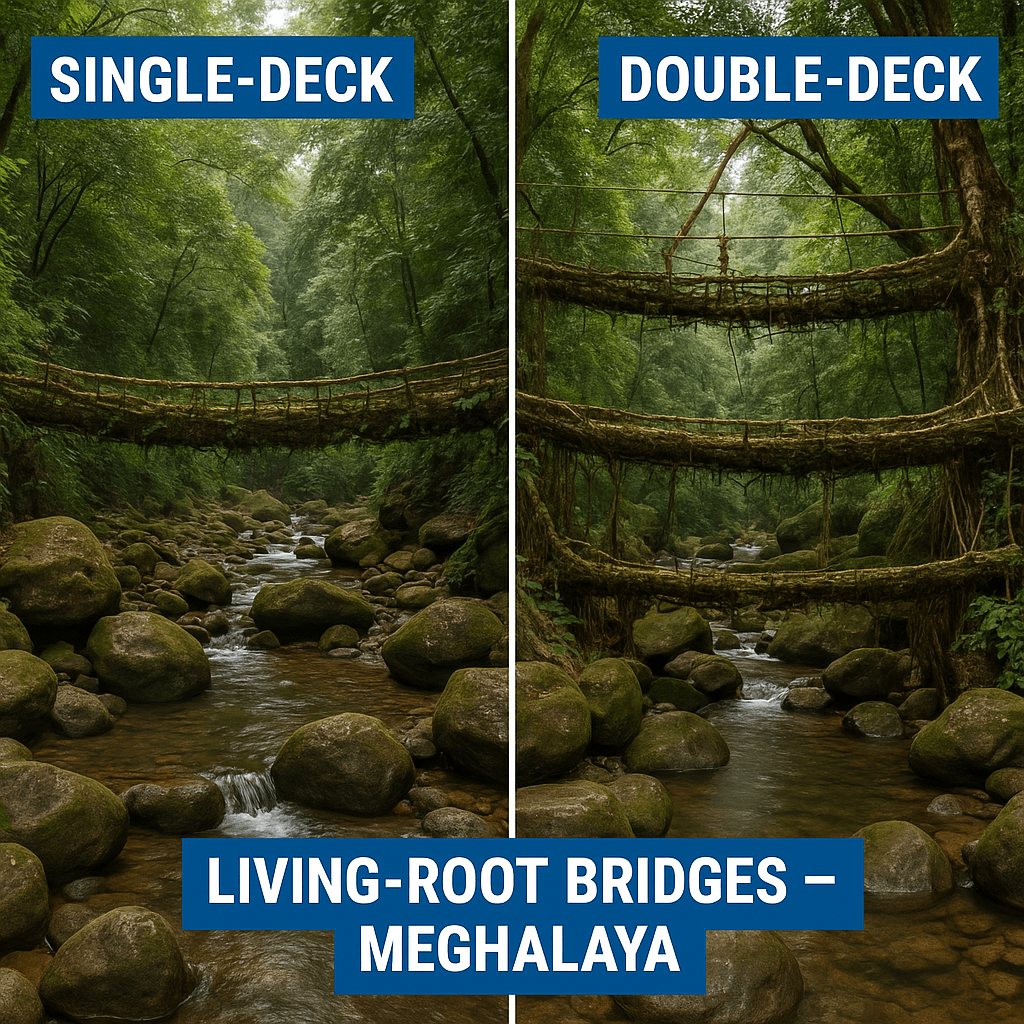Single-Deck vs Double-Deck Living-Root Bridges—Riwai’s Crowd-Free Alternative in Meghalaya
The Magic of Living-Root Bridges And The Choice Traveler’s Face
Meghalaya’s living-root bridges aren’t built; they’re grown. For generations, the Khasi and Jaintia communities have guided the aerial roots of Indian rubber trees across streams and gorges, weaving them over decades into resilient, self-renewing bridges. Today, travelers typically face a choice between two experiences:
- The Double-Deck Living-Root Bridge at Nongriat (near Tyrna, Sohra/Cherrapunji): iconic, dramatic, and deservedly famous—but also a demanding trek that’s rarely crowd-free in peak season.
- The Single-Deck Living-Root Bridge at Riwai (near Mawlynnong): gentler access, lush scenery, and a calmer atmosphere—perfect if you want the magic of root bridges without the marathon stair-climb.
If your dream is to see a living-root bridge without jostling for a photo, Riwai delivers. This guide breaks down the differences so you can choose the experience that matches your fitness, time, and travel style.
Single-deck vs double-deck: what’s the real difference for travelers?
1) Trek difficulty and time commitment
Double-Deck (Nongriat): Expect a serious stair workout—thousands of steep steps down (and back up) from Tyrna. Most travelers take 5–7 hours round-trip, longer if you add side trips to Rainbow Falls. Your knees will feel it; your lungs will too.
Single-Deck (Riwai): A short, undulating forest walk—typically 15–25 minutes from the parking area along a stone-paved path shaded by betel nut and banyan. There are steps, but it is family-friendly and manageable for first-timers.
Bottom line: If you’re short on time, traveling with kids or elders, or simply want a lower-effort bridge experience, Riwai wins.
2) Crowds and ambience
Nongriat: The double-deck structure is world-famous. In popular months, expect steady foot traffic, photo queues, and busy homestays.
Riwai: While not “undiscovered,” it’s decidedly calmer—arrive early or late in the day and you often get long, quiet moments with the bridge and the creek.
Bottom line: For crowd-free photos and a slower rhythm, choose Riwai—especially at sunrise or late afternoon.
3) Visual drama and engineering “wow”
Double-Deck: Two living walkways stacked vertically—visually spectacular, with multiple vantage points for wide-angle shots.
Riwai: A classic single span across a clear stream, framed by dense green walls. It’s a subtler kind of beauty—textural and intimate—where you can study the way roots are trained, braided, and buttressed.
Bottom line: If your heart is set on that two-tier postcard, Nongriat is unmatched. If you value details and intimacy, Riwai is gorgeous.
4) Time-of-year resilience and terrain
Nongriat: Monsoon brings slippery stairs and heavy runoff—beautiful, but slow and technical.
Riwai: Also lush in monsoon, with shorter exposure to slick terrain. In the post-monsoon months, its path is usually quick and stable.
Bottom line: Riwai is less weather-dependent for a casual visit.
5) Cultural footprint
Both bridges represent living heritage. The difference is scale: Nongriat has evolved into a multi-day trekking hub with numerous homestays; Riwai is tied to day trips around Mawlynnong (famous as one of India’s “cleanest” villages), where short walks and village lanes emphasize quiet cultural immersion.
Why Riwai is the best crowd-free alternative
If you want the soul of the living-root-bridge experience without the long stair descent, Riwai checks all the boxes:
- Short approach, big reward: A compact forest walk leads to a beautifully mature single-deck span—no endurance test required.
- Flexible itinerary: Combine with Mawlynnong village strolls and a Dawki/Shnongpdeng crystal-river detour for a diverse day out (village life, root bridge, river valley).
- Quality photos: Arrive early and capture misty creek shots, the braided roots’ textures, and reflections without people in frame.
- Perfect for families and mixed-ability groups: You can bring grandparents and school-age kids, and everyone still gets a “wow” moment.
Planning your visit: how to reach both bridges (so you can pick wisely)
Base towns and routes
Riwai (single-deck): Most travelers base in Shillong or Sohra (Cherrapunji). The drive to Mawlynnong–Riwai runs through East Khasi Hills to the India–Bangladesh border ridge, with scenic viewpoints. From the parking area, it is a signed path to the bridge.
Nongriat (double-deck): Base in Sohra; drive to Tyrna village (roadhead). The trek descends a long, stepped path, crossing steel and root bridges en route to the double-deck structure. Overnighting in Nongriat homestays makes the climb more relaxed and lets you visit Rainbow Falls.
Tip: If you have only one day, Riwai is realistic. If you have two days, consider Nongriat with an overnight.
Best season to visit (and what changes with weather)
- Post-monsoon (October–February): Prime time—cool air, fuller streams, strong greens. Trails are firm, skies clear for long views.
- Early monsoon (May–June): Forests glow; waterfalls roar; steps can be slick. Photographers love the saturated greens but plan slowly and carry rain gear.
- Peak monsoon (July–August): For die-hard rain lovers only—spectacular but demanding. If you must visit then, Riwai’s short approach is safer and more flexible than the long Nongriat descent.
- Spring (March–April): Warm days, gentler flow in creeks; good for comfortable hiking and village time.
Ethical travel and local etiquette—keep the bridges alive
Living-root bridges are community-grown infrastructure. Respect sustains them.
- Use the path and any designated footways—do not climb the root railings.
- No carving or hanging on young roots; those delicate tendrils are tomorrow’s load-bearing strands.
- Pack out every wrapper and bottle; villages maintain extraordinary cleanliness—be part of it.
- Dress modestly in villages; ask permission before photographing people or private courtyards.
- Hire local guides when possible; your fee supports stewardship and keeps the knowledge alive.
What to expect on the trail—and how to make it better
For Riwai (single-deck)
- Trail vibe: A stone-paved village path through betel nut groves and bamboo, birdsong all around.
- Time on foot: Usually 15–25 minutes each way depending on photo stops.
- Footwear: Lightweight hiking shoes or sandals with grippy soles; the rocks can be damp.
- Peak hours: Mid-morning to mid-afternoon. For solitude, aim for 8:00–10:00 a.m. or 4:00–5:30 p.m.
- Photography: Bring a polarizer to tame water glare; try low viewpoints to frame the braid of roots across the stream.
For Nongriat (double-deck)
- Trail vibe: A deep-valley staircase with suspension bridges, butterflies, and jungle soundscapes.
- Time on foot: 5–7 hours return, longer with Rainbow Falls.
- Footwear: Sturdy shoes with good tread; trekking poles help on the climb out.
- Crowd-avoidance: Start at first light or overnight in Nongriat to enjoy the bridge when tour groups have not arrived.
Single-deck vs double-deck: which one should you choose?
Choose Riwai if you want:
- A crowd-free alternative with minimal effort.
- A bridge visit that fits neatly into a one-day Meghalaya loop (Shillong–Mawlynnong–Riwai–Dawki–Shillong).
- Space for quiet observation and detail-rich photography.
Choose Nongriat if you want:
- The bucket-list two-tier structure and a full-day trekking adventure.
- The joy of staying in a valley homestay, swimming in blue pools, and exploring Rainbow Falls.
Do both if you can: Riwai first for the intro, then Nongriat when you are ready for the epic.
The story in the roots: how to look (and photograph) like a pro
- Follow the flow: Notice how roots are lashed to bamboo (or were, historically) and trained over years—look for secondary rootlets thickening into braided cables.
- Textures and patterns: Use a 50–85 mm lens (or phone portrait mode) to isolate the weave, lichens, and moss.
- Reflections: After rain, water pools at Riwai can mirror the arch—shoot low and level for symmetry.
- People scale: A single person crossing adds a sense of size—wait for a local in traditional attire if you are invited to photograph.
- Light: In the forest, light is dappled—cloudy days are your friend. If it is sunny, come early or late for soft beams through leaves.
Sample one-day plan built around Riwai (crowd-free focus)
- Early drive from Shillong (or Sohra) to Mawlynnong–Riwai; reach the Riwai trailhead by 8:00 a.m.
- Riwai Living-Root Bridge: slow walk, long photo session, creek time; be unhurried.
- Mawlynnong village: wander the lanes, meet artisans, sip local tea.
- Dawki–Shnongpdeng: mid-day drive for crystal-clear river views; go for a short boat ride or just rest by the water.
- Golden-hour stop at a ridge viewpoint; return to Shillong.
This route delivers root-bridge magic, village charm, and river beauty—with nothing feeling rushed.
What to pack (and what to leave behind)
- Light rain jacket, small umbrella, and a dry bag for phones and lenses—Meghalaya’s weather turns fast.
- Grip-soled footwear that can handle damp rock.
- Refillable bottle and snacks—but take all litter back.
- Polarizing filter or clip-on for phones to tame reflections.
- Small notes for local crafts and tea; some stalls may not accept digital payments in patchy signal zones.
Leave behind: loud Bluetooth speakers, drones where restricted, and heavy tripods on narrow village paths.
Responsible photography and storytelling
Travel content shapes expectations. When you share, geo-tag broadly (e.g., “East Khasi Hills” rather than pinpointing hidden side trails), remind readers to hire local guides, and emphasize bridge etiquette. These practices keep sensitive places from being overrun and ensure your blog helps the communities that keep these wonders alive.
A final nudge: why starting with Riwai makes sense
Think of Riwai as the gentle handshake with Meghalaya’s living-root world. You get the essence—living architecture, rainforest hush, cool water, and braided roots underfoot—without the pressure of a long descent or the bustle of an Insta-famous spot. Many travelers who begin at Riwai fall in love with the idea, then return for Nongriat when they have more time and stamina. That is a perfect progression: learn the etiquette, meet the communities, and then level up to the grand double-deck when you are ready.
Quick answers to high-intent questions
Is the Riwai Living-Root Bridge suitable for kids and elders?
Yes—with care. The path has steps and uneven stones, but the distance is short and there are places to rest. For toddlers or elders, consider a walking stick and slow pace.
Can I swim at Riwai?
Some pools are shallow and rocky. If you want a proper river swim, combine Riwai with Shnongpdeng or other designated spots where locals guide you.
What is the best time of day for crowd-free photos at Riwai?
Early morning or late afternoon—you will get softer light, fewer visitors, and misty creek moods after rainy nights.
Will I miss out if I skip the double-deck?
You will miss the iconic two-tier spectacle, yes. But you will gain a peaceful, unrushed encounter with a living-root bridge—and that often leaves a deeper impression than a quick, crowded selfie at a famous site.
The takeaway for your itinerary and your blog readers
- If you have one day and crave a crowd-free living-root bridge with minimal trekking, make Riwai your headline.
- If you have two days and want the bucket-list shot, plan Nongriat with a homestay.
- Do both if you can: let Riwai be the slow, soulful introduction; let Nongriat be the epic sequel.
Whichever path you take, walk lightly. Meghalaya’s bridges are alive—every careful footstep helps them grow stronger for the next generation of travelers.





